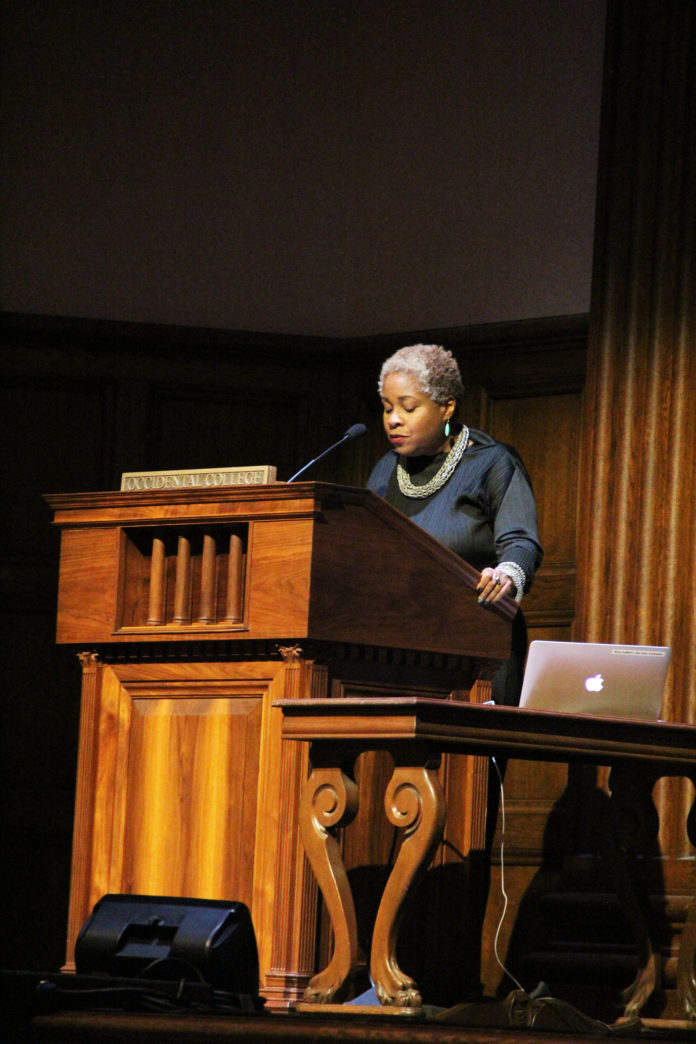
As a part of the 3rd LA Series, Occidental hosted a panel entitled “Amnesiac City: Bolstering Civil Memory in LA” in Choi Auditorium Nov. 4. The panel discussed how architecture and development in LA intersect with cultural histories, civic memory and social justice in the city. The panelists included LA chief design officer and Occidental professor of practice Christopher Hawthorne, LA Times columnist Frank Shyong, Great Streets Initiative Program Manager Wajenda Chambeshi, Kennard Design Group (KDG) President Gail Kennard and Occidental student Stella Ramos (senior).*
Hawthorne discussed organizing the Civic Memory Working Group, a group of around 35 architects, historians, artists and city employees, as a part of the mission to develop LA in innovative ways that engage the community.
“[The Civic Memory Working Group] will be thinking about ways in which our city can engage our histories more productively,” Hawthorne said. “We plan on preparing a written report, including significant specific recommendations for the city, that builds on the development groundwork laid out by the Department of Cultural Affairs by the end of next year.”
Ramos founded the Indigenous Students Association at Occidental and spoke about the importance of incorporating the urban indigenous perspective in future development.
“Conversations around indigeneity and native histories of Los Angeles shouldn’t be rooted in just history,” Ramos said. “It’s important to make sure that we are grappling with how we’re all implicated in those power structures, and how those structures manifest right now to reproduce cultural erasure, especially in an urban space with around 50,000 Native Americans, all from different multi-tribal backgrounds.”
Kennard directs KDG, the oldest black-owned architecture firm in the western U.S. She discussed how the demolishment of architectural structures rooted in injustice could counterintuitively contribute to historical erasure.
“Demolishing controversial structures doesn’t demolish the circumstances that initially led to the hatred of them,” Kennard said. “That’s the issue with erasure. Some of the painful things that make us feel good to get rid of, doesn’t really accomplish a lot in terms of moving the conversation or the social circumstances as we know them to be.”
Shyong writes a column in the LA Times focused on diversity and diaspora in LA and discussed his early reporting experience in LA neighborhoods that are historically underreported. According to Shyong, it is important to directly engage with communities in order to effectively represent them in projects.
“One of the most important audiences when you’re writing about a community is the member of that community,” Shyong said. “It takes humility, asking and immersion. What I try to achieve in my writing is the insight you get from fully embracing the idea that community members are experts about themselves.”
Wajande said the initiative aimed to rethink how LA develops infrastructure projects to more effectively serve community needs that vary across LA neighborhoods.
“The goal of the Grassroots Initiative is to change how the city delivers infrastructure projects, taking a community-focused approach to development projects,” said Wajande. “We engage different community organizations across the city, each with very unique experiences, and development becomes an organic and natural process where district infrastructure comes to reflect what the community is about.”
Hawthorne said his goal with the 3rd LA Series is to develop Los Angeles in an innovative manner that addresses urgent needs such as climate change and social justice while engaging directly with communities.
“It strikes me how many important and pressing questions facing American cities involve unwinding or undoing civic injustice,” Hawthorne said. “Confronting urbanism that went too far or had to do with erasure or silencing histories. This includes decolonization, ecological decarbonisation, incarceration, and anti-racism projects. How can cities prompt a successful productive reckoning around these issues?”
A recording of the panel can be accessed for free here.
*Stella Ramos is a staff writer for the Occidental.
![]()


































